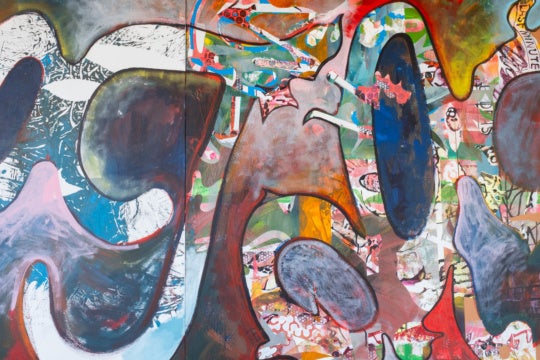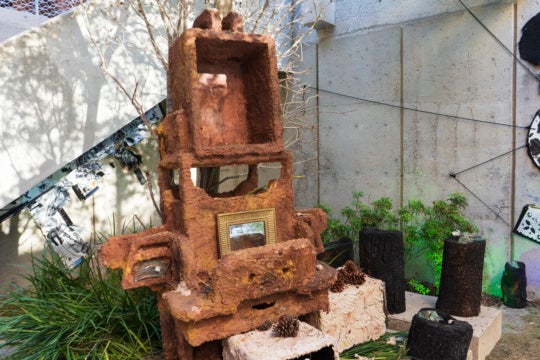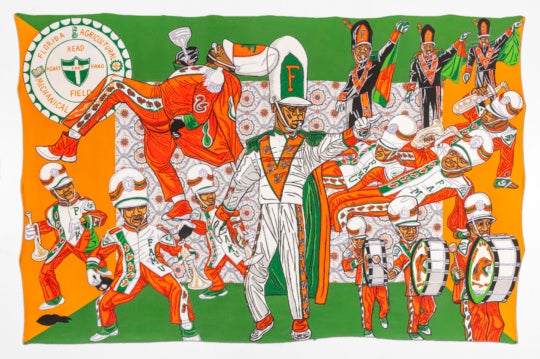
David Humphrey’s current solo show at Marcia Wood Midtown, “Between Machine and Animal,” contains the kind of work that might frustrate and baffle viewers. There is something seductive yet indescribable about his work—something that resists confident declarations, easy pigeonholes, and even consistent interpretation. Paintings convey meaning in ways other forms of communication cannot, and for work like Humphrey’s, words fall short of the visual experience. Just like a foreign tongue, Humphrey’s pictorial language may seem unfamiliar at first, but it slowly begins to make sense. The New York-based artist is, after all, an arts writer himself—publishing an anthology of essays and arts writing, Blind Handshake and chooses to understand works through written interpretation.

Humphrey’s work is marked by his vague, somewhat nonsensical narratives, his unapologetic use of color, and his quirky characters that engage in awkward (sometimes raunchy) social relations, all portrayed in a bold, amateurish manner. His work contains representational and abstract elements. It reflects the cartoonish style of Pop art, the color saturation of Matisse, the gestural strokes of Abstract Expressionism, and bizarre scenes of a Surrealistic nature that toe the line of Dada absurdity.
Take Your Coat Off (2015) is disorienting and astutely comedic. What looks like a speckled, colored goat floats in a daze toward the rafters of a room (which is upside down). A speech bubble says Take your coat off! Would you like a drink?

A grid of colorful and peculiar works on paper are displayed like studies on a wall. Some scenes are composed of flat space and folding planes —foregrounds and backgrounds compete and collide, perspectives shift. Alone, the abstract strokes of colors might seem arbitrary, but whether explicitly calculated or completely unencumbered, the colors and marks change the way figural and representational elements in the piece convey—or rather, suggest—meaning. They both muddle and accentuate what is there, directing the narrative in different manners and causing disruptions that rid the work of any predictable clichés.

In studio interviews, Humphrey speaks of his work’s many metaphors, which lend qualities of muddied and fading memories, and misremembered information. In Pondside (2014), a flame-colored boy looms large over a horizon, leaning toward a pair of empty high heels. In Paddock (2016) a child, with its back to the viewer, plays over a miniature corral with animals. As with many of his works, the viewer may vacillate between feeling they are in, and then outside, someone’s subconscious memories — looking at scenes and people who continue in their activities with the percipience that they are being observed.
Birds (2013) possess all of the peculiarities of Humphrey’s traditional two-“person” scenes. Some strokes are aggressive and some are subtle, but both variations are deliberate. In multiple interviews, Humphrey talks about making paintings “in collaboration” with himself, during which he employs different methods of painting in sections he defines. With this bit of insight, you can see the back and forth of styles, as if two creative personalities were sharing a brush and taking turns as one would in an exquisite corpse.

The most metaphoric piece of the exhibition is I Know What You are Thinking (2016). A cartoon-rendered man gestures with a brush; he appears to be painting the blotches of black, yellow, and teal beside him on the canvas. Viewers might want to make a face out of the marks, but there isn’t necessarily one there. The defined figure represents the artist, working with the viewer to create meaning. Humphrey relies on viewers’ top-down processing, the cognitive phenomena by which your perceptions and sensory data are influenced by your expectations, existing beliefs, and knowledge. One might argue that most of his work does this—and by design.

Hans Hoffman once wrote, “The ability to simplify means to eliminate the unnecessary so that the necessary may speak.” Humphrey only includes as much in the work as is necessary and then sometimes even less. The audience is only given pieces of a narrative and scene, the process of looking directs the story and completes the work. There is a constant exchange between what happens on the canvas and what happens in the mind. Most scenes look ordinary, and then a slight tweak of the peculiar skews the entire pageant. They are surreal, but the type of dream you’d wake up from confused, short of breath, and mildly embarrassed—like stills from a Freudian animated film. Humphrey’s work is as simple or enigmatic as the viewer wants it to be.
David Humphrey’s exhibition “Between Machine and Animal” is on view through November 26 at Marcia Wood Midtown.
Jac Kuntz is an arts writer, editor, journalist, and artist living in Atlanta. She is a recent graduate of the Masters of Arts Journalism program at the School of the Art Institute of Chicago. She also holds a BA in Psychology and a BFA in Painting with a concentration in art history from Clemson University.




